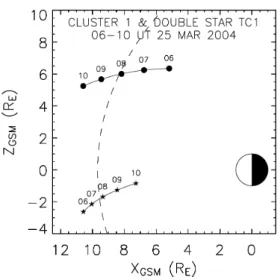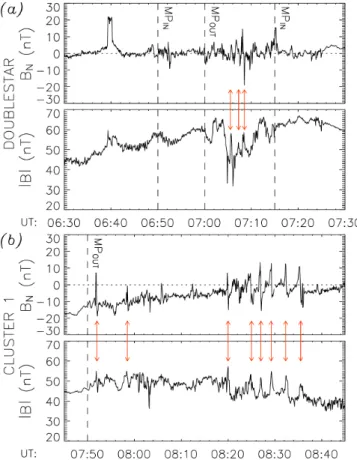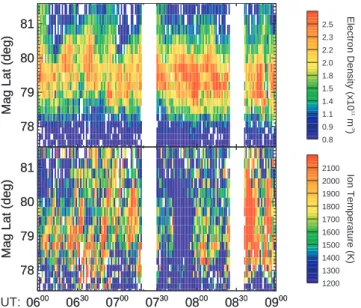HAL Id: hal-00317963
https://hal.archives-ouvertes.fr/hal-00317963
Submitted on 8 Nov 2005
HAL is a multi-disciplinary open access
archive for the deposit and dissemination of
sci-entific research documents, whether they are
pub-lished or not. The documents may come from
teaching and research institutions in France or
abroad, or from public or private research centers.
L’archive ouverte pluridisciplinaire HAL, est
destinée au dépôt et à la diffusion de documents
scientifiques de niveau recherche, publiés ou non,
émanant des établissements d’enseignement et de
recherche français ou étrangers, des laboratoires
publics ou privés.
Double Star, Cluster, and ground-based observations of
magnetic reconnection during an interval of duskward
oriented IMF: preliminary results
J. A. Wild, S. E. Milan, J. A. Davies, S. W. H. Cowley, Chris M. Carr, A.
Balogh
To cite this version:
J. A. Wild, S. E. Milan, J. A. Davies, S. W. H. Cowley, Chris M. Carr, et al.. Double Star, Cluster,
and ground-based observations of magnetic reconnection during an interval of duskward oriented IMF:
preliminary results. Annales Geophysicae, European Geosciences Union, 2005, 23 (8), pp.2903-2907.
�hal-00317963�
SRef-ID: 1432-0576/ag/2005-23-2903 © European Geosciences Union 2005
Annales
Geophysicae
Double Star, Cluster, and ground-based observations of magnetic
reconnection during an interval of duskward oriented IMF:
preliminary results
J. A. Wild1, S. E. Milan1, J. A. Davies2, S. W. H. Cowley1, C. M. Carr3, and A. Balogh3 1Dept. of Physics & Astronomy, University of Leicester, Leicester LE1 7RH, UK
2Rutherford Appleton Laboratory, Didcot, Oxfordshire, OX11 0QX, UK 3Blackett Laboratory, Imperial College, London SW7 2BZ, UK
Received: 21 January 2005 – Revised: 9 March 2005 – Accepted: 8 April 2005 – Published: 8 November 2005 Part of Special Issue “Double Star – First Results”
Abstract. We present a space- and ground-based study exploiting data from the coordinated Cluster and Double Star missions in order to investigate dayside magnetic re-connection under BY+dominated IMF conditions. In-situ
observations of magnetosheath flux transfer events com-bined with measurements of pulsed poleward and dawnward directed flows in the pre-noon sector high-latitude north-ern hemisphere ionosphere are interpreted as indications of pulsed magnetic reconnection during an interval in which the IMF remained relatively steady. Observations of newly-reconnected magnetic flux tubes anchored in the northern hemisphere both at mid-latitudes and in the vicinity of the subsolar point suggests that during BY+dominated IMF,
re-connection is not, as proposed previously, limited to the high-latitude magnetopause.
Keywords. Magnetopause, cusp, arid boundary layers –
Magnetosheath – Magnetospheric configuration and dynam-ics
1 Introduction
Despite being the principle mechanism by which solar wind energy and momentum are transferred to the magnetosphere, the magnetic reconnection process is not fully understood. The controlling influence that the orientation of the inter-planetary magnetic field (IMF) exerts over the location and spatial extent of the reconnection site is still uncertain. It is generally accepted that during periods of southward directed IMF, low latitude or subsolar reconnection plays a domi-nant role in solar wind-magnetosphere coupling, but during intervals of northward IMF the reconnection site shifts to higher latitudes, most probably in the vicinity of the cusps (e.g. Crooker, 1979; Coleman et al., 2000). However, the location of the reconnection site, or sites, during intervals
Correspondence to: J. A. Wild
(j.wild@ion)
of intermediate IMF orientation remains unclear (see Wild et al., 2005, and references therein), although a systematic dawnward/duskward shift of the reconnection region when the dawn-dusk component of the IMF dominates is well doc-umented. In this study we shall introduce ground- and space-based observations during a favourable conjunction of the Cluster and equatorial Double Star spacecraft (TC-1) with northern hemisphere ionospheric radars. This occurred dur-ing an interval of predominantly duskward oriented IMF on 25 March 2004. These data are then employed in order to constrain the location of the reconnection site. For this first results paper, we have limited our exploitation of the in-situ data to magnetic field measurement from the TC-1 and Cluster spacecraft 1 only. A comprehensive multi-spacecraft analysis including plasma measurements will form the basis of a later study.
2 Instrumentation
The positions of the various spacecraft relevant to this study are indicated in Fig. 1. During this interval, TC-1 was mov-ing inbound from the magnetosheath to the magnetosphere, encountering the boundary slightly southward of the sub-solar point at approximately 07:00 UT. The Cluster space-craft, moving in the outbound direction, encountered the mid-latitude magnetopause at ∼08:00 UT. Both of the space-craft encountered the magnetopause in the 11:00–12:00 MLT sector. In this preliminary review of the data, we shall in-troduce magnetic field measurements recorded by the flux-gate magnetometer (FGM) experiments on board the Cluster 1 and TC-1 spacecraft (Balogh et al., 2001; Carr et al., 2005, respectively). Ionospheric observations made by the Super-DARN network (Greenwald et al., 1995) and the EISCAT Svalbard radar (ESR: Wannberg et al., 1997) are compared to the in-situ magnetic field measurements recorded by Clus-ter 1 and TC-1. The northern hemisphere SuperDARN radar observations presented here synthesise ionospheric plasma
2904 J. A. Wild et al.: Cluster, Double Star, and ground-based observations of FTEs
Fig. 1. The locations of the Cluster 1 (circles) and equatorial
Dou-ble Star (stars) spacecraft in the noon-midnight meridian during the interval under scrutiny. The location of a Shue et al. (1997) magne-topause is also indicated.
velocity measurements from 9 radars using the “map poten-tial” technique of Ruohoniemi and Baker (1998) in order to estimate the global ionospheric convection pattern. We also present measurements of the high-latitude ionosphere made by the 32 m steerable dish of the incoherent-scatter ESR fa-cility, which was directed northward from Svalbard at low elevation (azimuth 336◦, elevation 30◦). Finally, upstream interplanetary magnetic field conditions are provided by the magnetic fields (MAG) experiment (Smith et al., 1998) on board the Advance Composition Explorer (ACE) spacecraft located some 235 RE upstream of the Earth.
3 Observations
Figure 2 presents a comparison between the IMF clock an-gle (defined as arctan(BY/BZ)) measured at the ACE
space-craft and the equivalent parameter derived from Cluster 1 and TC-1 data. The ACE data have been time-shifted by 80 min in order to account for the propagation delay of IMF structures from the spacecraft to the magnetopause. Dur-ing the interval that extended from 06:00 to 09:00 UT, the IMF was typically oriented duskward (BY+) and northward
(BZ+). The uniform time delay applied to the upstream
data brings the ACE clock angle variations into broad agree-ment with those observed at Cluster 1 and TC-1 when these spacecraft were located in the magnetosheath. For example, prior to ∼07:00 UT, TC-1 was located in the magnetosheath where the clock angle orientation closely matched the equiv-alent lagged IMF data from ACE (i.e. duskward and gener-ally northward). TC-1 entered the magnetospheric cavity at 06:52 UT where it observed the northward pointing magne-tospheric field (∼0◦clock angle). TC-1 emerged back into the magnetosheath (or possibly the magnetosheath bound-ary layer) for approximately 15 min at ∼07:00 UT before
re-Fig. 2. A comparison of the magnetic field clock angle observed at
ACE, Cluster 1, and TC-1 between 06:00–09:00 UT. Cluster 1 and TC-1 magnetopause crossings discussed in the text are indicated by appropriately coloured dashed lines.
entering the magnetosphere for final time. Similar examina-tion of the Cluster 1 magnetic field clock angle indicates that the spacecraft was located within the mid-latitude magneto-spheric cavity (northward and duskward oriented magnetic field) until ∼07:50 UT when the spacecraft emerged into a magnetosheath-like magnetic field configuration. Prelimi-nary plasma data (not shown) indicates that between 07:50– 08:00 UT Cluster 1 traversed the magnetopause several time, definitively entering the magnetosheath at 08:00 UT.
Figure 3 presents an overview of magnetic field obser-vations from the Double Star TC-1 (Fig. 3a) and Cluster 1 (Fig. 3b) spacecraft. In order to highlight FTEs in the vicin-ity of the magnetopause boundary, the data are presented in a boundary-normal coordinate system (Russell and Elphic, 1978). More specifically we show the component of the measured magnetic field in the direction normal to the lo-cal magnetopause (BN) and the total magnetic field strength
(|B|). In the case of the TC-1 data, the local boundary normal was determined via minimum variance analysis (MVA) of the 07:00 UT magnetopause encounter, the derived unit nor-mal having GSM components [+0.96, −0.13, −0.25]. De-tailed examination reveals this determination to be robust, as well as being consistent with the expected outward point-ing boundary normal in the pre-noon, low (southern) latitude sector. Cluster 1’s departure from the magnetosphere was not accompanied by a definitive reorientation of the mea-sured magnetic field. Consequently, MVA proved to be un-satisfactory in determining the boundary normal in the case of this, and the other Cluster spacecraft. Instead, we have estimated the local orientation of the magnetopause by us-ing a Shue et al. (1997) model magnetopause constrained to pass through the location of Cluster 1 at 08:00 UT (the ap-proximate time of the magnetopause crossing). The outward normal to the model magnetopause at this location was thus found to have GSM components [+0.89, −0.14, +0.42].
Inspection of the in-situ magnetometer data reveals char-acteristic bipolar fluctuations in the BN component of the
Fig. 3. Magnetic field measurements from the (a) TC-1 and (b)
Cluster 1 spacecraft. The component of the magnetic field normal to the local magnetopause and the overall magnetic field strength are presented. Magnetopause crossings and FTEs discussed in the text are indicated by dashed lines and red arrows, respectively.
magnetic field observed at both Cluster and TC-1. We inter-pret these classic FTE signatures as evidence of pulsed mag-netic reconnection at the dayside magnetopause. Beginning with the TC-1 data, Fig. 3a presents 60 min of data begin-ning at 06:30 UT. At this time Cluster was located within the magnetospheric cavity, moving outbound towards the mid-latitude pre-noon sector magnetopause. The clearest bipolar signatures occurred when TC-1 was located in the magne-tosheath/boundary layer between 07:00 and 07:15 UT. Sev-eral large (∼10 nT peak-to-peak) oscillations were observed, at least three of which appear to be associated with enhance-ments in |B| (indicated by arrows in Fig. 3a). The timing of these oscillations with respect to the |B| enhancements sug-gest that these are normal (positive-negative) polarity fluc-tuations (Russell and Elphic, 1978). Additional FTE-like signatures were also observed at 06:52 UT and from 07:22– 07:25 UT, although these are less clear and do not appear to be associated with clear |B| enhancements. Observations of FTEs by Cluster 1 began shortly after the spacecraft first en-countered the magnetopause at ∼07:50 UT. The first bipolar FTE signature was observed at 07:52 UT (accompanied by rapid fluctuations in |B|), with several other clear examples observed over the next 45 min. Figure 3b presents data
dur-Fig. 4. SuperDARN northern hemisphere ionospheric convection
pattern at 07:30 UT on 25 March 2004, derived using the technique of Ruohoniemi and Baker (1998). The location of the ESR and the magnetic footprints of the Cluster 1 and TC-1 spacecraft are also indicated.
ing the 07:45–08:45 UT interval, by which time TC-1 was moving at inbound low latitudes towards perigee. The ob-servations culminated in a series of at least 6 classic, nor-mal (positive-negative) polarity bipolar oscillations. In these cases, the bipolar perturbations were associated with |B| en-hancements and field-tilting effects in the plane of the mag-netopause (not shown). The observed bipolar FTE signatures at both spacecraft exhibited normal polarity were indicative of northern hemisphere flux tubes contracting northward un-der the action of the field tension following magnetic recon-nection (e.g. Russell and Elphic, 1978).
When in the magnetosphere, the northern hemisphere ionospheric footprints of both Cluster and Double Star were located within the fields-of-view of the easternmost pair of SuperDARN radars. Figure 4 presents the ionospheric con-vection pattern at 07:30 UT, inferred from all available north-ern hemisphere SuperDARN data. At this time, both space-craft were located within the magnetosphere, TC-1 having recently traversed the low latitude magnetopause from the magnetosheath (where FTEs were observed), while Clus-ter 1 was approaching the mid-latitude magnetopause (where FTE signatures were also observed). The estimated iono-spheric flow pattern is as expected for convection driven by a dominant IMF BY component (in this case duskward)
with ionospheric plasma in the noon sector flowing dawn-ward and poledawn-ward into the polar cap as newly reconnected magnetic field lines, one end of which remains embedded in the solar wind, respond to magnetic tension forces and the influence of the anti-sunward directed solar wind flow. Detailed examination of line-of-sight velocity measurements from individual radars located in the noon and pre-noon sec-tor reveals pulsed ionospheric flows (PIFs) – bursts of high speed (∼1000 m s−1) ionospheric plasma flow directed into
2906 J. A. Wild et al.: Cluster, Double Star, and ground-based observations of FTEs
78 79 80 81
Mag Lat (deg)
0.8 0.9 1.1 1.4 1.5 1.8 2.0 2.2 2.3 2.5 Electron Density (x10 11 m -3 ) 78 79 80 81
Mag Lat (deg)
0600 0630 0700 0730 0800 0830 0900 78
79 80 81
Mag Lat (deg)
1200 1300 1400 1500 1600 1700 1800 1900 2000 2100 Ion Temperature (K) 0600 0630 0700 0730 0800 0830 0900 UT: 78 79 80 81
Mag Lat (deg)
Fig. 5. Ionospheric electron density and ion temperature
measure-ments made by the ESR during the interval of interest.
the polar cap (for a discussion of PIFs, see Wild et al., 2001). The ESR also recorded poleward moving structures in the high-latitude ionosphere north of Svalbard (MLT∼UT+3 h). Figure 5 presents an overview of electron density and ion temperature measurements during the 3-h interval of interest. Regions of elevated ion temperature, which can be consid-ered a proxy for enhanced ion flow velocity, were observed moving poleward at ∼1.5 km s−1. While requiring further detailed anlysis, these structures appear to be roughly cor-related with depletions in the measured ionospheric electron density (the enhanced ion temperatures most likely resulting in an increased rate of electron-ion recombination).
4 Discussion & conclusions
The 07:30 UT satellite footprints shown in Fig. 4 indicate the ionospheric region corresponding to reconnecting mag-netospheric field lines located adjacent to the magnetopause. On 25 March 2004, this region was situated in the vicin-ity of the EISCAT Svalbard radar and elements of the Su-perDARN radar network. Just prior to this time, the TC-1 spacecraft had observed magnetosheath FTEs in the vicin-ity of the subsolar region. Shortly afterwards, the Cluster spacecraft observed FTEs at the same magnetic local time, but in the mid-latitude magnetosphere/magnetosheath. Al-though the observations of FTEs were separated by ∼1 h, the IMF conditions remained approximately constant through-out (i.e. duskward dominated but generally northward point-ing). We therefore infer that during this interval dayside magnetic reconnection was relatively steady, resulting in the FTE signatures observed at the low- and mid-latitude mag-netopause. Given the steady IMF conditions, we consider it likely that the multiple magnetopause encounters recorded by TC-1 were a result of variations in the solar wind
dy-namic pressure (although the unavailability of upstream solar wind plasma data does not allow us to confirm this). The pulsing of ionospheric plasma flow dawnwards and pole-wards across the high-latitude noon-sector ionosphere, as ob-served by the ESR and SuperDARN radars, is further ev-idence of magnetic reconnection at the dayside ionosphere driving ionospheric convection typical of +BY dominated
IMF conditions. Bursty flows such as the observed PIFs are now accepted as the ionospheric counterparts of FTEs. While the temporally displaced in-situ observations presented here do not allow a one-to-one comparison of FTEs at widely separated latitudes, they are evidence of newly-reconnected magnetic flux tubes propagating over much of the surface of the magnetopause, including the subsolar region, during
BZ>0, |BY| BZ IMF conditions. This is not consistent
with an antiparallel description of magnetic reconnection un-der BY+ dominated IMF conditions (e.g. Crooker, 1979)
which suggests that newly-opened flux tubes would not tra-verse the subsolar region, as they appear to do here. A future investigation will therefore consider the motion and recent history of reconnected magnetic field lines in this region un-der BY dominated IMF conditions.
Acknowledgements. We thank the ACE Science Center and
the EISCAT scientific association for the data presented here. Research at Leicester was supported by PPARC grant number PPA/G/O/2003/0013.
Topical Editor T. Pulkkinen thanks O. Amm and
K. A. McWilliams for their help in evaluating this paper.
References
Balogh, A., Carr, C. M., Acuna, M. H., et al.: The Cluster Magnetic Field Investigation: overview of in-flight performance and initial results, Ann. Geophys., 19, 1207–1217, 2001,
SRef-ID: 1432-0576/ag/2001-19-1207.
Carr, C., Brown, P., Zhang, T. L., et al: The Double Star magnetic field investigation: instrument design, performance and high-lights of the first year’s observation, Ann. Geophys., 23, 2713– 2732, 2005.
Coleman, I. J., Pinnock, M., and Rodger, A. S.: The ionospheric footprint of antiparallel merging regions on the dayside magne-topause, Ann. Geophys., 18, 511–516, 2000,
SRef-ID: 1432-0576/ag/2000-18-511.
Crooker, N. U.: Dayside merging and cusp geometry, J. Geophys. Res., 84, 951–959, 1979.
Greenwald, R. A., Baker, K. B., Dudeney, J. R., et al.: Darn/SuperDARN: a global view of the dynamics of high-latitude convection, Space Sci. Rev., 71, 761–796, 1995. Ruohoniemi, J. M. and Baker, K. B.: Large-scale imaging of
high-latitude convection with Super Dual Auroral Radar Network HF radar observations, J. Geophys. Res., 103, 20 797–20 811, 1998. Russell, C. T. and Elphic, R. C.: Initial ISEE magnetometer results: magnetopause observations, Space Sci. Rev., 22, 681–715, 1978. Shue, J.-H., Chao, J. K., Fu, H. C., et al.: A new functional form to study the solar wind control of the magnetopause size and shape, J. Geophys. Res., 102, 9497–9511, 1997.
Smith, C. W., Acuna, M. H., Burlaga, L. F., et al.: The ACE Mag-netic Fields Experiment, Space Sci. Rev., 86, 613–631, 1998.
Wannberg, G., Wolf, L., Vanhainen, L. G., et al.: The EISCAT Sval-bard radar: A case study in modern incoherent scatter radar sys-tem design, Radio Sci., 32, 2283–2308, 1997.
Wild, J. A., Cowley, S. W. H., Davies, et al.: First simultaneous observations of flux transfer events at the high-latitude magne-topause by the Cluster spacecraft and pulsed radar signatures in the conjugate ionosphere by the CUTLASS and EISCAT radars, Ann. Geophys., 19, 1491–1508, 2001,
SRef-ID: 1432-0576/ag/2001-19-1491.
Wild, J. A., Milan, S. E., Cowley, S. W. H., et al.: Simultaneous in-situ observations of the signatures of dayside reconnection at the high and low latitude magnetopause, Ann. Geophys., 23, 445– 460, 2005,


